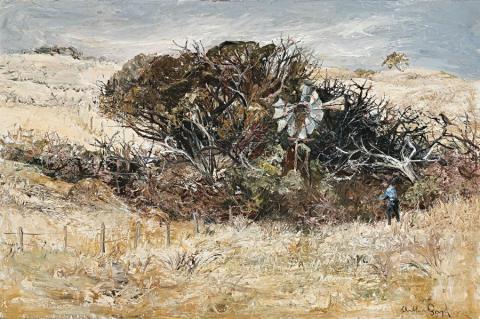THE BURNT SPINNEY, 1957
ARTHUR BOYD
oil on composition board
61.0 x 91.0 cm
signed lower right: Arthur Boyd
Australian Galleries, Melbourne
(label attached verso)
Mr A. Bruce Wenzel, Melbourne
Thence by descent
Private collection, Melbourne
Gould Galleries, Melbourne
Private collection, Melbourne
Deutscher and Hackett, Melbourne, 16 April 2008, lot 42
Private collection, Sydney
Arthur Boyd Retrospective, Art Gallery of New South Wales, Sydney and touring to National Gallery of Victoria, Melbourne; Tasmanian Museum and Art Gallery, Hobart; and Art Gallery of Western Australia, Perth, 1993–94, cat. 76
Philipp, F., Arthur Boyd, Thames and Hudson, London, 1967, cat. 8.21, p. 255
Pearce, B., Arthur Boyd Retrospective, Art Gallery of New South Wales, Sydney, 1993, cat. 76, p. 92
From late 1956 until his departure for England in 1959, Boyd embarked upon a series of landscapes 'exemplified here by The Burnt Spinney ' which constitute his most exhaustive exploration of the genre since the celebrated, highly successful Berwick and Wimmera paintings of 1948-51. Encapsulating the artist's frequent oscillation between naturalistic and imaginative impulses in his art, significantly such scenes were undertaken concurrently with his highly controversial 'Love, Marriage, and Death of a Half-Caste' theme (famously known as the 'Bride' series). Interestingly, discussing precisely this dualism within his oeuvre, Franz Philipp suggests that the two tendencies are not necessarily so diametrically opposed, for, Boyd had always been more 'literal' than his contemporaries; he is a 'literalist of the imagination' as much in his naturalistic landscape vision as in the creation of his compulsive and compelling inner images.'1 Thus, if Boyd's approach to the landscape is naturalistic, it is also creative insofar as he invariably selects and revisits three types of Australian (or more specifically, Victorian) topographies " the primeval bush; the sparse coast and inland shrub; and a more intimate pastoral scene.
Redolent with themes and motifs from his earlier work, the landscapes painted during Boyd's final years in Melbourne elucidate well this selective response to his iconography. In The Burnt Spinney for example, the harsh, sun-parched terrain and golden strawlike palette unmistakably echoes the artist's Wimmera paintings while the farmer and windmill evoke the 'motifs of habitation' which punctuate his Brueghelesque pastorals at Berwick and Harkaway. Where previously Boyd's interpretations of the landscape had been European-inspired, now, however, his approach is distinctly more Antipodean and personal. Significantly, when eighteen of these later landscapes were exhibited for the first time at Australian Galleries, Melbourne in 1959, an enthusiastic Allan McCulloch exclaimed:'in these landscapes [Boyd] has come to an 'old master' phase, probably the best, if not his last.'2 Offering respite in a time of severe and disciplined artistic struggle, indeed such works not only presented Boyd with an opportunity to explore a genre and medium which had eluded him in the preceding years. More importantly perhaps, they served as a reaffirmation of both his links to a monumental past tradition and his own artistic beginnings. As Ursula Hoff muses, 'The most unusual element in Boyd's performance is the persistence with which he returns to his origins; the way in which' his own work becomes a reserve from which he draws new ideas and to which he returns in between exploration of new ground.'3
1. Philipp, F., Arthur Boyd, Thames and Hudson, London, p. 80
2. McCulloch, A., Herald, Melbourne, 14 April 1959
3. Hoff, U., The Art of Arthur Boyd, Andre Deutsch, London, 1986, p. 83
VERONICA ANGELATOS
